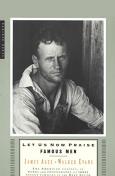BKMT READING GUIDES
Let Us Now Praise Famous Men: The American Classic, in Words and Photographs, of Three Tenant Families in the Deep South
by Walker Evans, James Agee
Kindle Edition : 500 pages
1 club reading this now
0 members have read this book
In the summer of 1936, Pulitzer Prize–winning writer James Agee and photographer Walker Evans set out on assignment for Fortune ...
Introduction
In the summer of 1936, Pulitzer Prize–winning writer James Agee and photographer Walker Evans set out on assignment for Fortune magazine to explore the daily lives of white sharecroppers in the South. Their journey would prove an extraordinary collaboration—and a watershed literary event.
Let Us Now Praise Famous Men was published to enormous critical acclaim. An unsparing record in words and pictures of this place, the people who shaped the land, and the rhythm of their lives, it would eventually be recognized by the New York Public Library as one of the most influential books of the twentieth century—and serve as an inspiration to artists from composer Aaron Copland to David Simon, creator of The Wire. With an additional sixty-four archival photos in this edition, Let Us Now Praise Famous Men remains as relevant and important as when it was first published over seventy-seven years ago.
“One of the most brutally revealing records of an America that was ignored by society—a class of people whose level of poverty left them as spiritually, mentally, and physically worn as the land on which they toiled. Time has done nothing to decrease this book’s power.” —Library Journal
Editorial Review
Just what kind of book is Let Us Now Praise Famous Men? It contains many things: poems; confessional reveries; disquisitions on the proper way to listen to Beethoven; snippets of dialogue, both real and imagined; a lengthy response to a survey from the Partisan Review; exhaustive catalogs of furniture, clothing, objects, and smells. And then there are Walker Evans's famously stark portraits of depression-era sharecroppers--photographs that both stand apart from and reinforce James Agee's words.Assigned to do a story for Fortune magazine about sharecroppers in the Deep South, Agee and Evans spent four weeks living with a poor white tenant family, winning the Burroughs's trust and immersing themselves in a sharecropper's daily existence. Given a first draft of the resulting article, the editors at Fortune quite understandably threw up their hands--as did several other editors who subsequently worked with a later book-length manuscript. The writing was contrary. It refused to accommodate itself to the reader, and at times it positively bristled with hostility. (What other book could take Marx as the epigraph and then announce: "These words are quoted here to mislead those who will be misled by them"?) Response to the book was puzzled or unfriendly, and Let Us Now Praise Famous Men sputtered out of print only a few short years after its publication. It took the 1960s, and a vogue for social justice, to bring Agee's masterwork the audience it deserved.
Yet the book is far more interesting--aesthetically and morally--than the sort of guilty-liberal tract for which it is often mistaken. On an existential level, Agee's text is a deeply felt examination of what it means to suffer, to struggle to live in spite of suffering. On a personal level, it is the painful, beautifully written portrait of one man's obsession. In its collaboration with Evans's photographs, the book is also a groundbreaking experiment in form. In the end, however, it is more than merely the sum of its parts. Let Us Now Praise Famous Men is, quite simply, a book unlike any other, simmering with anger and beauty and mystery. --Mary Park
Discussion Questions
No discussion questions at this time.Book Club Recommendations
Recommended to book clubs by 0 of 0 members.
Book Club HQ to over 90,000+ book clubs and ready to welcome yours.
Get free weekly updates on top club picks, book giveaways, author events and more








